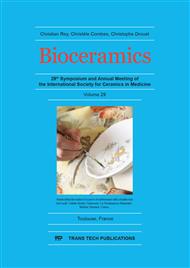p.29
p.34
p.39
p.47
p.52
p.56
p.61
p.69
p.75
Hardness Evaluation of Carbonate Apatite Cement Based on Various Ratio of Precursor
Abstract:
Carbonate Apatite (CO3Ap) cement is considered as an ideal bone substitute due to its biocompatibility and osteoconductivity. Also, CO3Ap cement has the chemical composition that closes to natural bone. During cement preparation, precursors play an important role that affects the properties of CO3Ap cement. Cement hardness is one of the important properties that need to be evaluated before the obtained cement can be applied as a bone substitute. Therefore, the purpose of this study is to determine the effect of precursor ratio of CaCO3 and CaHPO4 on the hardness level of CO3Ap cement. In the present study, the CO3Ap cement was prepared from CaCO3 and CaHPO4. Both Commercial and synthesized CaCO3 were used. The CO3Ap cement obtained from commercial CaCO3 was used as a control group. Synthesized CaCO3 was obtained from Indonesian natural limestone. Three different CaCO3:CaHPO4 ratios, 40:60, 30:70 and 20:80 were mixed with 1 mol/L Na2HPO4. Samples were kept at 37°C with 100% relative humidity for 24 hours then tested using micro Vickers hardness testing machine. The micro Vickers hardness of the control group with CaCO3:CaHPO4 ratio of 40:60, 30:70 and 20:80 were 5.09 VHN, 6.34 VHN, and 6.73 VHN, respectively. Meanwhile, the micro Vickers hardness of the CO3Ap cement obtained from synthesized CaCO3 were 6.22 VHN, 7.50 VHN, and 10.37 VHN for the CaCO3:CaHPO4 ratio of 40:60, 30:70 and 20:80, respectively. The micro Vickers hardness level of CO3Ap cement precursor ratio from the lowest to the highest was 40:60 < 30:70 < 20:80. In conclusion, the precursor ratio significantly affects the hardness level of the CO3Ap cement. The hardness level of CO3Ap cement obtained from synthesized CaCO3 was higher compared with that obtained from commercial CaCO3.
Info:
Periodical:
Pages:
52-55
Citation:
Online since:
November 2017
Price:
Сopyright:
© 2017 Trans Tech Publications Ltd. All Rights Reserved
Share:
Citation:


